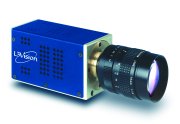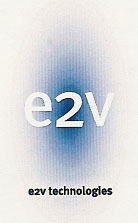L3Vision™ 24/7
Overcast Starlight Camera
"EXPECT EXCEPTIONAL RESULTS IN ALL LIGHTING CONDITIONS"
 e2v technologies UK introduces the Charge Multiplication CCD Sensor - a revolutionary solid-state sensor. This surveillance camera enables very low light level imaging at TV frame rates and above without the limitations of vacuum tube based systems. This new technology provides the capability to operate a CCTV camera in environments and conditions that previously required Intensified CCDs', but without the numerous disadvantages of this outdated technology! With performance in excess of the best ICCDs (Intensified Charge Coupled Devices), L3Vision™ starlightsensor excels in applications of photon-starved situations such as night-time surveillance. However, with the ability to simultaneously operate across the full range of light levels, L3Vision™ brings a huge increase in system flexibility.
e2v technologies UK introduces the Charge Multiplication CCD Sensor - a revolutionary solid-state sensor. This surveillance camera enables very low light level imaging at TV frame rates and above without the limitations of vacuum tube based systems. This new technology provides the capability to operate a CCTV camera in environments and conditions that previously required Intensified CCDs', but without the numerous disadvantages of this outdated technology! With performance in excess of the best ICCDs (Intensified Charge Coupled Devices), L3Vision™ starlightsensor excels in applications of photon-starved situations such as night-time surveillance. However, with the ability to simultaneously operate across the full range of light levels, L3Vision™ brings a huge increase in system flexibility.
'L3Vision is used by the Australian Parliament House Canberra'
![]() Video experiences at bottom of page
Video experiences at bottom of page ![]()
Operators are now able to utilise CCTV cameras employing a charge multiplying CCD sensor for night time and low light imaging. The use of this new technology will allow the end-user to obtain extreme low light imaging to full daylight imaging without having to adjust the camera for broad variations in the lighting conditions. Also, as the camera is not intensified, there is no danger of damaging the camera with bright lights or daylight.
The e2v technologies L3Vision-06APS Overcast Starlight camera incorporates:
- Amplified 1" CCD Sensor.
- High resolution - 430TVL pph.
- Anti-Blooming technology.
- Peltier cooled CCD (dramatically reduces dark current noise that accumulates during extended integration periods. The result is a high performance
video imaging camera with low noise, wide dynamic range, low-light capability, and spectral response to near IR). - Liquid Crystal Polymer Shutter eliminating frame shift smear.
The basis of this new starlight technology is a novel on-chip output amplifier circuit that is capable of operating at an equivalent output noise of less than one electron at TV frame rate. The senor is a frame transfer device which functions by converting photons to charge in the image area, then transferring this charge through the image and store sections into the readout register. Following transfer through the read out register, the charge is multiplied in the gain register by Impact Ionisation prior to conversion to a voltage by a low noise output amplifier.

The on-chip gain register overcomes the fundamental noise limitations of traditional on-chip charge to voltage conversion and off-chip video amplification stages. Imaging under overcast starlight conditions (0.1 mLux scene) or the detection of single photons at video frame rates is now possible using totally solid-state L3Vision™ technology.
Features:
- Exceptional Daylight Resolution.
- 576 pixels per line.
- No Image Burn or Damage to Sensor from High Light Levels.
- High Intra-Scene Dynamic Range.
- No Haloing or Scintillations.
- Auto On-Chip Gain Control.
- Immune to Overexposure.
- Rapid Recovery from Highlights Overload.
- Very High Contrast Levels.
- Full Daylight Operation Without Damage to the Camera whilst also able to Operate in Virtual Darkness.
- Sensor will Image at Faceplate Illumination Levels Down to 0.01mlux, Equivalent to Overcast Starlight with a f/1.4 lens.
Applications:
- 24/7 covert/overt day/night surveillance.
- Defence applications.
- Vehicle mounting with HUD's.
- Perimeter & installation Security.
The L3Vision™ sensors are not damaged by over exposure and so provide a robust imaging solution. The on-chip gain can be controlled by an applied bias voltage giving a high degree of flexibility to respond to changing light levels. The sensors can be used in high light level conditions, just like a conventional CCD, and transfer smoothly and rapidly to extremely demanding low light situations. E2V's L3Vision™ cameras utilise this feature within the automatic gain control circuitry and so, using an appropriate lens, provide true 24-hour video capability from a single sensor.
The amplified CCD is undamaged by sudden or prolonged light overloads well in excess of normal operating levels. This robustness/versatility has a profound impact on system life-cycle costs.
Movie clip experiences:
Driver Night Vision experience (WMV, 1.1MB - 44 sec.)
Please note: These clips are supplied to assist you in getting an overview of what is achievable. They do not represent the full capability obtainable with the L3Vision.
| Technical specifications: | |
|
Sensor |
Typical Performance |
|
Signal Processing |
Mechanical |


